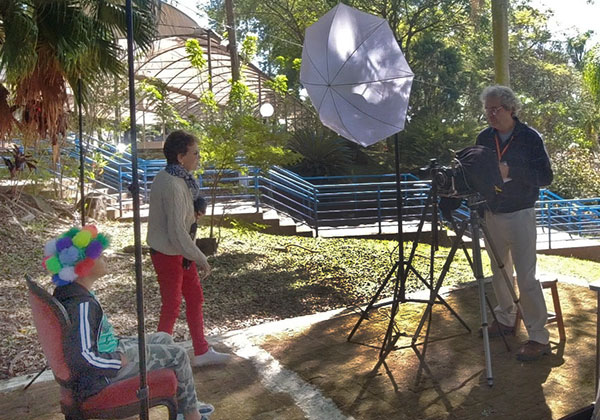
I don’t think millennials have ever heard of it. But, since I’m from the last century, I remember very well that when I was a child I often heard the expression “watch the birdie”. It was a cliché, almost a password, with which photographers would warn their subjects. It was the signal that everyone should get ready to pose because the click would come next. I thought it was just a joke, since no birds were visible. It was the same as saying look at the camera, but in a funny way, using a jargon that everyone knew.

But recently I was surprised in getting acquainted with this little bird. Yes, it existed and was used to capture the attention of children, especially, so that the photographer could release the shutter while the subject was still and “watching the bird”. This must have been especially useful in studios when photographing with sheet film or glass plates. The process between one click and the next takes longer and does not allow for several photos in rapid succession. Photographer and subject need to be synchronized and the bird was the instrument for this synchronization. Below, the bird mounted on an Excelsior camera in 13×18 cm format. This would be a typical camera for needing the bird. Watch the video at the end of the page to understand the step-by-step process for each photograph.

I first saw this little photography gadget appear at an auction house specializing in photography. I was surprised to learn that photographers actually used a mechanical bird, capable of even singing, to act as a trap to capture the attention of their subjects. I bid, but someone was far more keener than me to have the bird. It was only on my third attempt that I managed to close the deal for a reasonable price. It was the equivalent of 60 USD. It came from Australia and arrived very dirty but intact. The only thing missing was the base, but that’s very easy to improvise. Otherwise, just a cleaning got it back in shape.
It is very difficult to find information about the bird. I looked for studios or photographers who could give a testimonial about its use, perhaps a photo of a making-of, but what I found was a website called “Smile for me Toys”, with some interesting information.
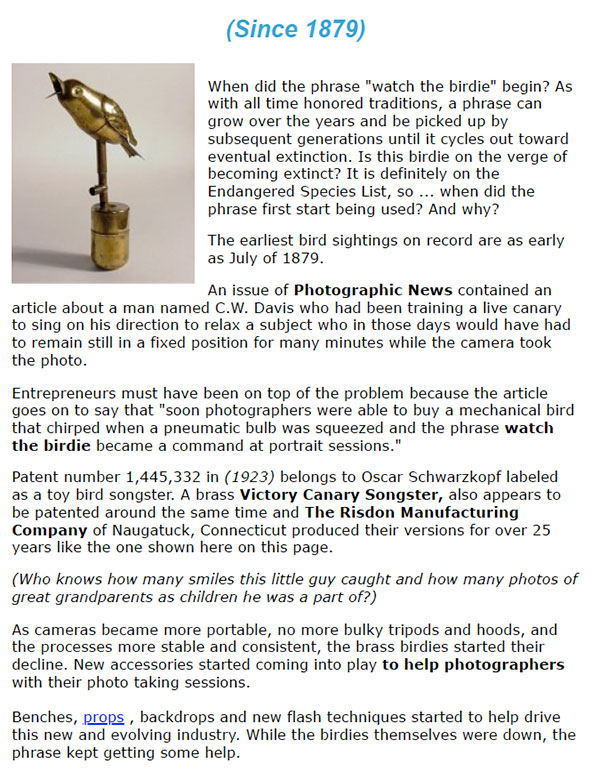
I looked for the article mentioned in The Photographic News, but I couldn’t find a digital copy from 1879. What I found was the aforementioned American patent from February 13, 1923, in the name of Oscar Schwarzkopf, of the firm Victory Sparkler & Specialty Co., with the title Toy Bird Songster. The design in this patent corresponds exactly to the bird I have, but I can’t say for sure that it is from that brand. It may be from The Risdon Manufacturing Company, mentioned above, and it is very similar too. Probably, due to its constructive simplicity, it may have been copied by other firms, outside or even within the scope of the patent.
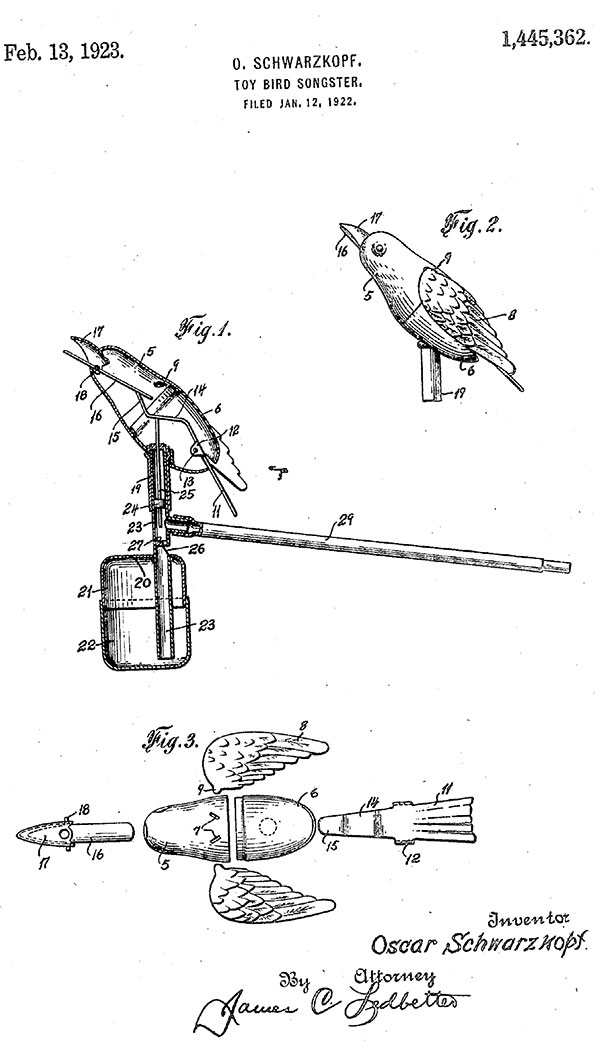
This is the patent application page that shows the details of the singing bird. Although simple, it is very ingenious and produces a surprising effect in its singing.
When air enters tube 29, blown in by the photographer or through a rubber bulb, it separates into two streams. The one that goes up will project a rod, a small piston, to move the bird’s tail and beak, since these are articulated. The stream that goes down will activate a whistle (27 in the drawing). The reservoir that forms the base of the gadget must be filled with water. What happens is that the air pressure causes the water level to drop inside the tube and the note emitted by the whistle changes to a lower pitch because the column of air vibrating inside the tube lengthens and changes to a lower frequency. This has the effect of generating an authentic “bird sound” every time a little air is forced through tube 29. It is a very convincing effect that gets around the fact that it would be banal if it were simply a whistle.
One interesting thing is that in the patent application the author does not mention anything relating to the use specifically in photography. We read: “This invention relates to musical toys and, more particularly, to improvements in singing canaries made to imitate the movements of a singing bird and produce the chirping or trilling sound thereof. An object of this invention is to improve and simplify toy canaries so that the same are practical for production in large quantities and sale at comparatively low prices.”

I also found this small ad aimed at distributors. It talks about operas, orchestras… but no photography.
This indicates that the photographers’ canary belongs to a much broader and more diverse category, the category of automatons. Before electronics and microprocessors, many mechanisms, whether simple like the singing canary or extremely sophisticated like this lady below who can write a letter, have enchanted many generations with their ingenuity and relative realism.
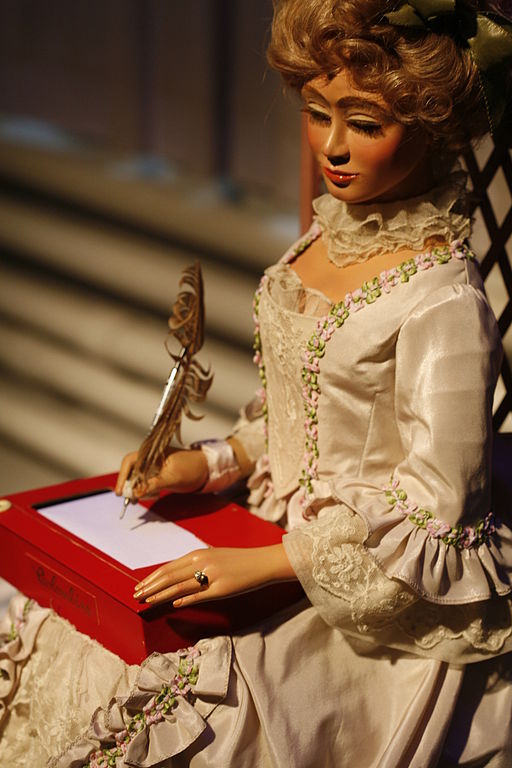
The canary was probably appropriated by photographers who associated it with the cliché “watch the birdie”, but it was originally conceived as just another toy of the type that emulates a living being, a toy that “does something” like humans or animals in this case. In the patent application, the author even says that it is about “improvements in singing canaries”, which clearly indicates that there were other “competitors”.
But after I published this post, I happened to come across one of these competitors, much older than Oscar Schwarzkopf’s canary and, interestingly, sold as a photography item. I was leafing through an 1885 catalog from a distributor called Indermill, scanned on the Pierci Vaubel website, and found the canary as “The American Songster.”
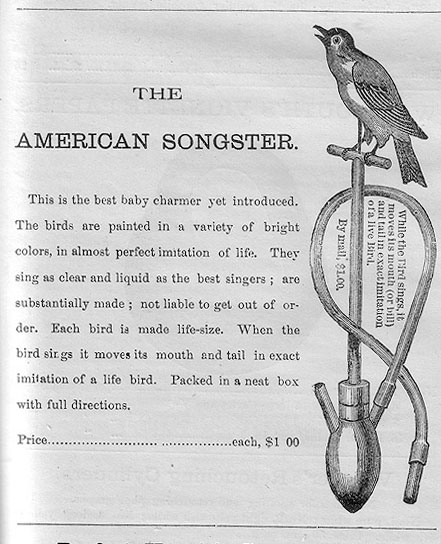
It is presented as a “baby charmer”. There is no explicit mention of its use in a photography studio. But its placement among laboratory items and then lenses and cameras makes me suspect that its use would be so obvious that it didn’t need to be mentioned.
Another reference to the baby charmer appears in Beaumont Newhall’s book The Daguerreotype in America (page 124 in the 3rd edition). He recounts that a certain E. T. Whitney of Rochester, as early as 1855, when exposure times for a daguerreotype were around 20 seconds, used the canary to hold the attention of children and take the photograph: “a little toy bird, that I make sing inside the camera, occasionally showing part of it to attract attention to the instrument [the camera].”
Below is a video I made, a simulation, just to show, for those not familiar with, the step-by-step for taking a photograph with sheet film, or glass plate, in a view camera. I hope it will convince you that at the moment of the click, the person being photographed could easily be completely disconnected from the action, distracted by something else or with their own thoughts. That’s where the “watch the birdie” comes in.
Thanks!
what started as a search for the history of the phrase: “Watch the birdie!” , bifurcated into a search for two spellings of “birdy”, and as well their historical usages.
Delighted to see and much enjoy Your helpful and playful video demonstration of early camera portrait technique.